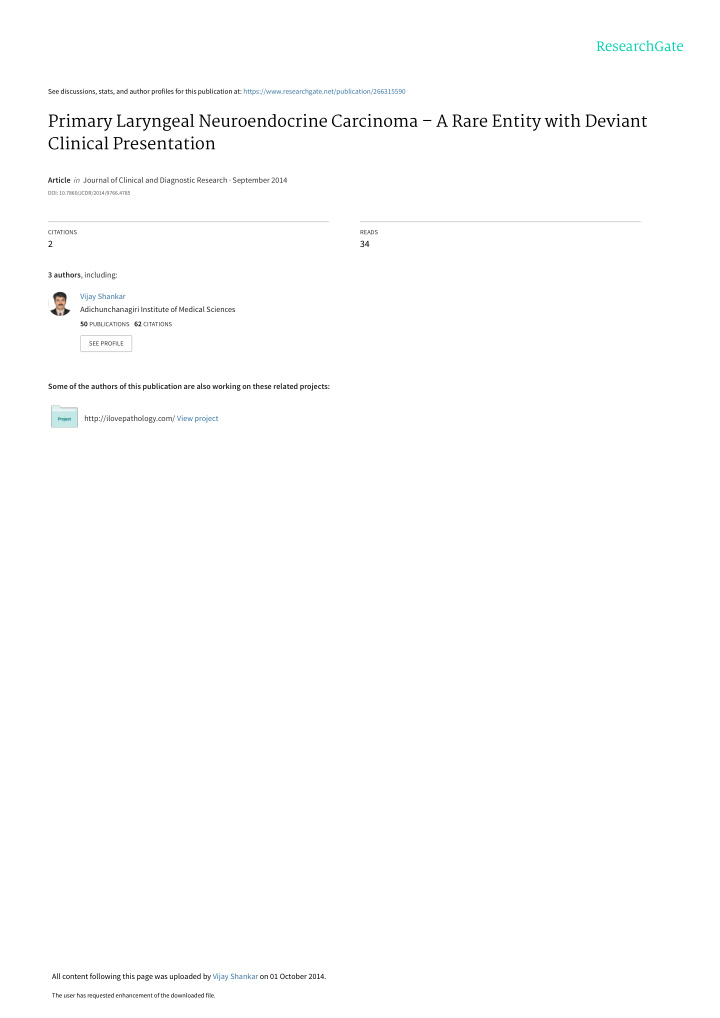



See discussions, stats, and author profiles for this publication at: https://www.researchgate.net/publication/266315590 Primary Laryngeal Neuroendocrine Carcinoma – A Rare Entity with Deviant Clinical Presentation Article in Journal of Clinical and Diagnostic Research · September 2014 DOI: 10.7860/JCDR/2014/9766.4785 CITATIONS READS 2 34 3 authors , including: Vijay Shankar Adichunchanagiri Institute of Medical Sciences 50 PUBLICATIONS 62 CITATIONS SEE PROFILE Some of the authors of this publication are also working on these related projects: http://ilovepathology.com/ View project All content following this page was uploaded by Vijay Shankar on 01 October 2014. The user has requested enhancement of the downloaded file.
DOI: 10.7860/JCDR/2014/9766.4785 Case Report Primary Laryngeal Neuroendocrine Pathology Section Carcinoma – A Rare Entity with Deviant Clinical Presentation HEMALATHA A. L 1 , ANOOSHA K 2 , AMITA K 3 , VIJAY SHANKAR S 4 , AVADHANI GEETA K 5 ABSTRACT Primary laryngeal neuroendocrine carcinomas are rare neoplasms. WHO classifies them under five categories of which, the moderately differentiated neuroendocrine carcinoma is synonymous with atypical or malignant carcinoid tumour. We report a rare case of primary laryngeal neuroendocrine carcinoma with an unusual and misleading clinical presentation. The initial cytological diagnosis of secondary neuroendocrine carcinoma in the cervical lymph node led to the suspicion of primary neuroendocrine carcinoma in the larynx. Keywords: Atypical carcinoid, Laryngeal, Neuroendocrine with fine chromatin and inconspicuous nucleoli. A few bi and CASE REPORT multinucleated tumour giant cells were also seen. Foci of vascular A 55-year-old male patient presented with pain abdomen and invasion were seen. multiple skin nodules over the anterior abdominal wall and left cervical lymphadenopathy. On local examination, the abdominal skin Sections from the abdominal skin nodules showed a subepithelial, nodules were firm to hard in consistency and the largest measured infiltrating, malignant tumour with monomorphic cells arranged in 3 x 2 cms. The left cervical lymph node was single, discrete and firm sheets, nests, organoid, trabecular and mosaic patterns [Table/ to hard in consistency. FNAC was performed on the abdominal skin Fig-2c,2d]. They exhibited moderate degree of pleomorphism at nodules and the left cervical lymph node. FNAC smears studied from places [Table/Fig-3a]. The cells had moderate to abundant granular both the left cervical lymph node and the abdominal skin nodules cytoplasm and nuclei with salt and pepper type of chromatin [Table/ showed similar cytological features. The smears were highly cellular Fig-3b]. The tumour cells were arranged in rosette- like fashion. and showed predominantly dispersed cell population of uniform Focal, large areas of necrosis were seen [Table/Fig-3c]. tumour cells [Table/Fig-1a] in sheets, clusters, rosettes and tumour Based on these histopathological features, Primary laryngeal balls [Table/Fig-1b]. The cytoplasm was moderate, eosinophilic and neuroendocrine carcinoma (Moderately differentiated) with multiple granular. The nuclei were round to oval, with stippled chromatin and metastatic deposits in the skin over the anterior abdominal wall was inconspicuous single prominent nucleolus [Table/Fig-1c]. Plenty diagnosed. of atypical mitoses were present [Table/Fig-1d]. In addition, many Immunohistochemistry of the laryngeal and skin nodule biopsies multinucleated giant cells and bizarre tumour cells were seen. showed positivity for Chromogranin and Synaptophysin. The patient Extracellular eosinophilic basement membrane- like material was was referred to an oncology center for further management and also seen [Table/Fig-2a]. hence lost to follow up. A cytological diagnosis of metastatic deposits in left cervical lymph node and multiple skin nodules over the abdominal wall DISCUSSION from neuroendocrine carcinoma was offered with a suggestion to Neuroendocrine tumours are relatively rare in the head and neck investigate for the primary in gastrointestinal tract or larynx. region [1-3]. Laryngeal neuroendocrine carcinoma is an uncommon A thorough clinical workup including laryngoscopy revealed a neoplasm accounting for less than 1% of laryngeal tumours. It is the laryngeal supraglottic growth which was biopsied and submitted for most common non-squamous carcinoma of larynx [1-3]. WHO has histopathological examination (HPE). The abdominal skin nodules classified laryngeal neuroendocrine neoplasms under five categories were also excised and submitted for HPE. as typical carcinoid, atypical carcinoid, Small-cell carcinoma, combined small cell and non- small cell carcinoma (Squamous cell Sections from the supraglottic growth revealed hyperplastic stratified and Adenocarcinoma) and Paraganglioma [4,5]. squamous epithelium and a tumour in the subepithelium which was composed of monomorphic tumour cells arranged predominantly Moderately differentiated or grade II primary laryngeal neuroendocrine in diffuse sheets separated by fibrovascularseptae [Table/Fig-2b]. carcinoma as per the WHO criteria was diagnosed in the present Occasional rosettes and trabecular patterns were observed. The case based on the cytological and histomorphological features. It tumour cells had moderate eosinophilic cytoplasm, round nuclei usually presents with hoarseness of voice, dysphagia and pain. It is [Table/Fig-1a]: FNAC of cervical lymph node showing monomorphic tumour cells (MGG, ×1000) [Table/Fig-1b]: FNAC of skin nodule with tumour cells in rosettes (H&E, ×400) [Table/Fig-1c]: FNAC showing tumour cells with eosinophilic cytoplasm and fine nuclear chromatin (H&E,×1000) [Table/Fig-1d]: FNAC showing atypical mitotic figures (H&E,×1000) 7 Journal of Clinical and Diagnostic Research. 2014 Sep, Vol-8(9): FD07-FD08
Recommend
More recommend